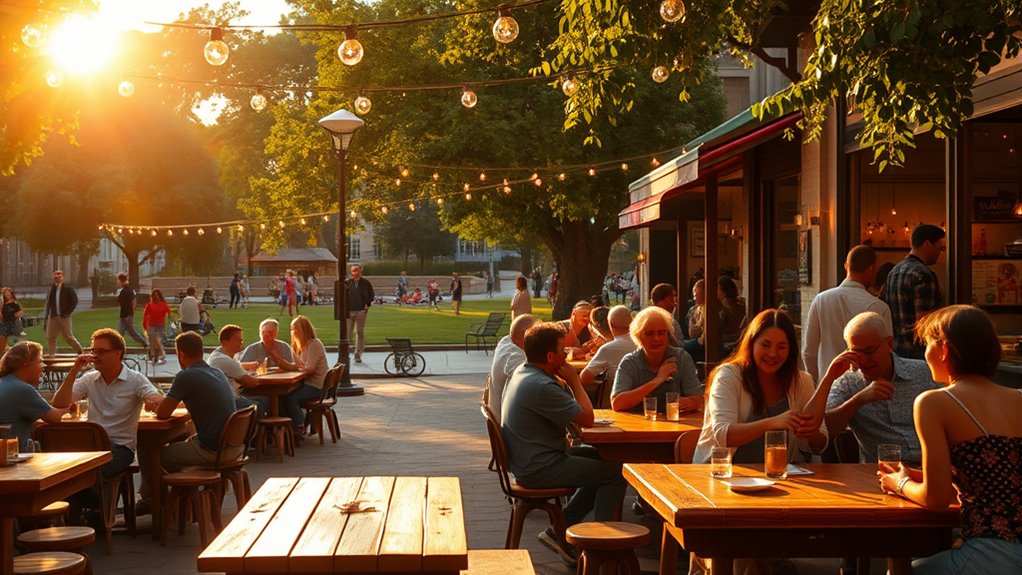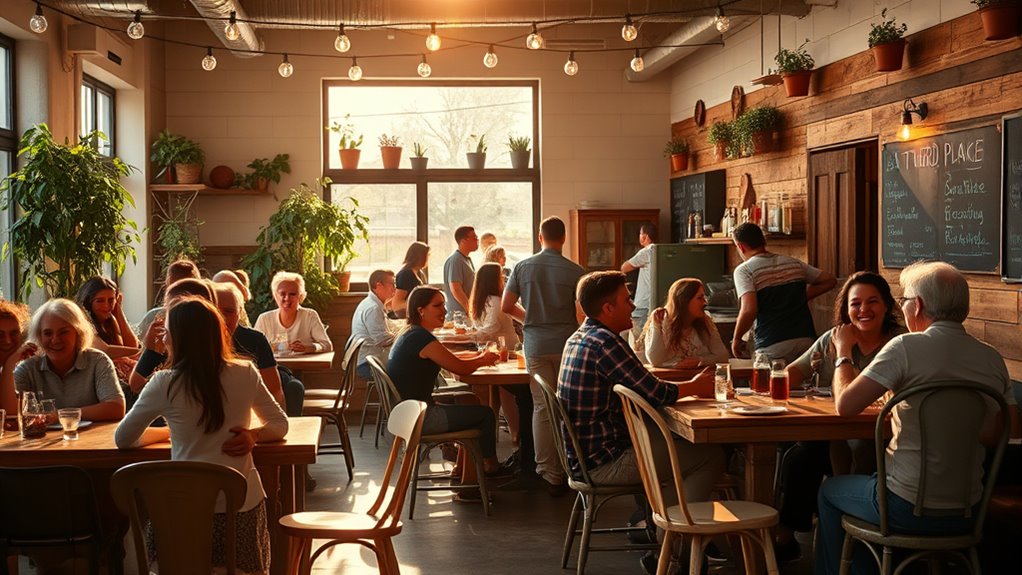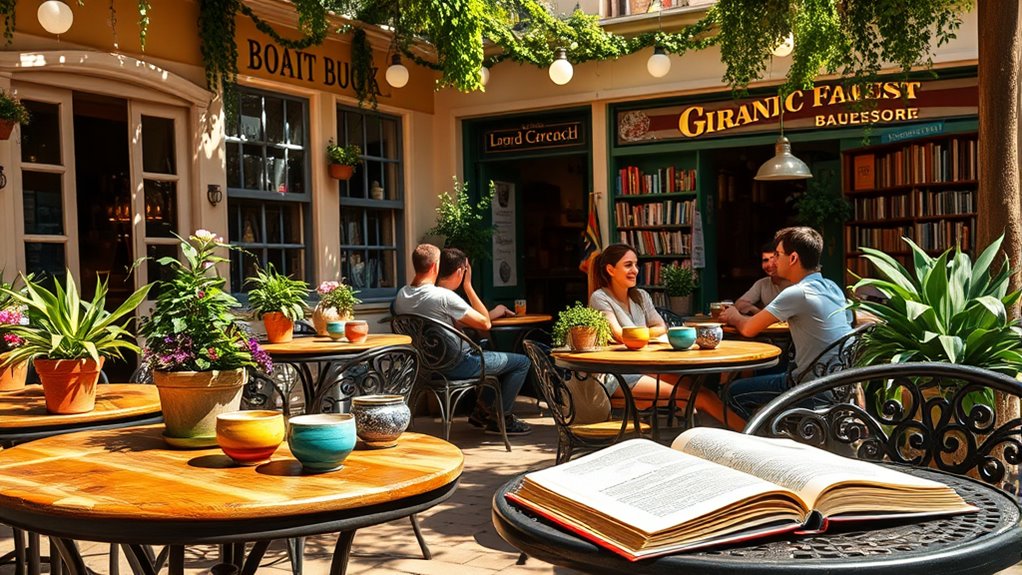A secondary hangout, or third place, boosts your happiness by providing a relaxed space outside home and work where you can connect genuinely with others. These social environments help reduce stress, lift your mood, and foster community bonds through casual interactions. They support emotional resilience and fight loneliness, making you feel more grounded and supported. If you’re curious about creating or finding your perfect third place, there’s more to explore on how these spaces can supercharge your well-being.
Key Takeaways
- Third places provide relaxed environments that foster social bonds, boosting happiness and emotional well-being.
- Secondary hangouts like coffee shops or parks enhance community connection outside work and home routines.
- Regular visits to these spaces release feel-good chemicals such as oxytocin and dopamine, improving mood.
- They help reduce social isolation, build trust, and create a sense of belonging essential for happiness.
- Customizing and intentionally engaging in secondary hangouts strengthens resilience and promotes a balanced, joyful life.
Understanding the Concept of the Third Place

A third place is a social environment separate from home and work where people naturally gather and connect. These community spaces act as social anchors, offering a welcoming environment where you can relax and build relationships. Unlike your home or workplace, third places foster informal interactions and a sense of belonging. They’re often coffee shops, parks, libraries, or local clubs—places that encourage spontaneous conversations and community bonding. By frequenting these spaces, you create opportunities for social engagement outside your daily routines. Understanding the concept of the third place helps you realize how crucial these environments are for your well-being. They serve as hubs where connections are made, friendships are strengthened, and the fabric of community is woven tighter. Recognizing the importance of community spaces can also enhance resilience and foster support networks during challenging times, especially when they incorporate welcoming atmospheres that promote open communication. Additionally, these environments often facilitate emotional expression and help reduce feelings of loneliness, further boosting overall happiness and mental health. Cultivating these social connections within third places can be instrumental in building a strong support system that contributes to mental and emotional well-being.
The Psychology Behind Third Places and Happiness

When you spend time in third places, your brain releases feel-good chemicals like oxytocin and dopamine, which boost your mood and reduce stress. These environments promote social bonding, helping you feel connected and supported. These spaces often encourage open conversations and genuine interactions, fostering a sense of community. The environment influence of third places creates a relaxed, welcoming space that encourages open conversations and genuine interactions. Your psychological well-being benefits from this sense of community and belonging. Here’s a snapshot:
| Environment Aspect | Effect on Happiness | Social Bonding Impact |
|---|---|---|
| Casual Atmosphere | Reduces stress | Builds trust |
| Comfort Level | Enhances relaxation | Fosters friendships |
| Community Vibe | Increases belonging | Strengthens ties |
| Accessibility | Promotes frequent visits | Deepens connections |
This synergy between environment and social bonding fuels happiness in third places. Additionally, creating a comfortable setting can involve considering factors like environmental design, which influences how welcoming and engaging the space feels. Recognizing the importance of psychological well-being can help in designing these spaces to maximize their positive effects.
Examples of Popular Secondary Hangouts

Have you ever wondered where people gather beyond their primary social spots? Many turn to coffee shops or community centers as their secondary hangouts. Coffee shops aren’t just for caffeine; they’re places to relax, work, or meet friends in a casual setting. Community centers offer a broader range of activities, from classes to social events, fostering a sense of belonging. These spots provide a welcoming environment outside home and work, where you can connect with others or enjoy some alone time. They often host informal gatherings, book clubs, or hobby groups that help build relationships. By spending time in these popular secondary hangouts, you create opportunities for spontaneous interactions, deepening your social life and boosting your happiness outside of your primary routines. Incorporating intentional social spaces into your routine can further enhance your overall well-being and sense of community. Recognizing the importance of cultural content and other support systems can also help solidify stability as you build new routines in your post-divorce life.
How Third Places Foster Community and Connection

Third places help you build informal bonds with others, making connections feel natural and easy. They encourage social interactions that break down barriers and foster a sense of belonging. By spending time there, you strengthen community ties and create lasting relationships.
Building Informal Bonds
Third places serve as essential spaces where people naturally build informal bonds, fostering a sense of community and belonging. In these environments, casual conversations happen effortlessly, helping you connect with others beyond surface-level interactions. Shared experiences, like enjoying a game or collaborating on a project, deepen these bonds over time. These interactions create a relaxed atmosphere where trust and familiarity grow organically.
- Engage in spontaneous chats that break down social barriers
- Participate in group activities that promote teamwork
- Share stories and personal insights that build empathy
Encouraging Social Interactions
Because they provide a relaxed environment, third places naturally encourage social interactions that strengthen community bonds. Here, casual networking happens effortlessly, making it easy to meet new people or reconnect with familiar faces. Spontaneous interactions often arise during conversations over coffee or shared activities, breaking down social barriers. These unplanned moments foster trust and camaraderie, creating a sense of belonging. Unlike formal settings, third places invite open dialogue and genuine connection without pressure. You’re more likely to engage in casual networking, sharing ideas or experiences that deepen relationships. The relaxed atmosphere encourages people to stay longer and participate more actively. As a result, third places become vibrant hubs where spontaneous interactions spark friendships and reinforce community ties.
The Mental Health Benefits of Having a Third Place

Having a third place can help you feel less isolated and more connected to others. It provides a safe space to share experiences and build friendships, which can improve your mood. Additionally, regularly engaging in these environments strengthens your emotional resilience over time.
Reduces Social Isolation
Regularly visiting a third place can considerably decrease feelings of social isolation. When you make these spots part of your routine, you foster meaningful social connection and strengthen community building. This ongoing engagement helps break down loneliness by providing a supportive environment where you can share experiences and build relationships.
- Creates opportunities for casual conversations that combat loneliness
- Encourages ongoing interactions that deepen social bonds
- Promotes a sense of belonging within a community
Boosts Emotional Resilience
Spending time in a third place not only fosters social bonds but also considerably enhances your emotional resilience. Regularly engaging in these environments helps you develop better emotional regulation, making it easier to handle life’s ups and downs. When you connect with others in a relaxed setting, you build a support system that strengthens your ability to bounce back from setbacks. These spaces also aid in stress management by providing a calming environment where you can unwind and reflect. Over time, this consistency boosts your capacity to stay composed under pressure and manage difficult emotions more effectively. Having a reliable third place becomes a mental safeguard, helping you maintain stability and resilience amidst daily challenges.
Creating Your Own Ideal Third Place

Creating your own ideal third place starts with identifying the atmosphere and activities that make you feel most comfortable and engaged. Think about the type of community spaces and social environments where you naturally connect and unwind. Do you prefer casual coffee shops, vibrant parks, or cozy libraries? Consider how these spaces foster interaction and relaxation for you. Customizing your third place guarantees it fits your personality and needs. To deepen your experience, focus on:
- Choosing locations that encourage genuine conversations and interactions
- Incorporating elements that promote a relaxed, welcoming vibe
- Ensuring accessibility and comfort to invite regular visits
The Role of Third Places in Urban and Rural Settings

Third places serve essential social functions in both urban and rural areas, shaping how communities connect and thrive. In cities, coffee shop culture creates vibrant hubs where people gather, fostering conversations and relationships beyond work or home. These spaces often become informal community centers, supporting local networks. In rural areas, community gardens act as crucial third places, bringing neighbors together to share resources and knowledge. They cultivate a sense of belonging and cooperation, strengthening social bonds. Whether in bustling urban environments or quiet countryside, third places provide accessible spaces that promote interaction, reduce isolation, and build community resilience. By bridging different settings, they help ensure everyone has a place to connect, relax, and feel part of something larger.
Tips for Making the Most of Your Secondary Hangout

To make the most of your secondary hangout, start by approaching it with intentionality. Focus on fostering community engagement and personal reflection to deepen your experience. Set specific goals, like meeting new people or exploring new activities, to stay engaged. Be present and actively listen, which helps build meaningful connections. Regularly reflect on your experiences to understand what brings you joy and growth in this space.
- Seek opportunities to contribute, whether through volunteering or organizing events, to strengthen community bonds.
- Dedicate time for personal reflection, noting how your hangout impacts your happiness and sense of belonging.
- Stay open-minded and embrace new interactions, enriching your secondary hangout with diverse perspectives.
Frequently Asked Questions
How Do Third Places Differ Across Various Cultures?
You’ll notice that third places vary widely across cultures due to social norms and traditions. In some societies, cafes or tea houses serve as social hubs, emphasizing communal bonds, while others favor outdoor markets or temples for gathering. These cultural variations shape how people interact and foster a sense of belonging, making third places essential for happiness. Understanding these differences helps you appreciate diverse ways communities create welcoming, engaging environments.
What Are Some Common Barriers to Accessing Third Places?
Imagine you want to visit a local coffee shop but face transportation barriers, making it tough to connect outside your home. Common barriers include social isolation, which can make it hard to feel comfortable in new places, and transportation issues that limit access. These obstacles prevent you from enjoying the benefits of third places, reducing opportunities for social interaction and community building. Overcoming these barriers boosts happiness and social well-being.
Can Virtual Spaces Serve as Effective Third Places?
Virtual communities and digital gatherings can serve as effective third places by providing accessible, inclusive spaces for social connection. You can engage in meaningful conversations, share interests, and build relationships from anywhere. While they might lack some in-person warmth, they foster a sense of belonging and community. As a secondary hangout, these virtual spaces can boost happiness by keeping you connected with others, especially when physical meetups aren’t possible.
How Do Third Places Influence Local Economies?
You see, third places like community hubs boost local economies by attracting visitors and encouraging spending. They create vibrant gathering spots that support small businesses, cafes, and shops, leading to increased economic impact. When you frequent these spaces, you help sustain local employment and foster community connections, which in turn stimulate economic growth and resilience. Fundamentally, third places are crucial in strengthening the financial and social fabric of your community.
What Are Innovative Ways to Create New Third Places?
You can create new third places by transforming community hubs into vibrant spaces that foster connection and creativity. Consider establishing creative co-working spaces that blend work and socializing, or repurposing empty buildings into lively gathering spots. Incorporate local art, music, and food to make these places inviting. By prioritizing accessibility and inclusivity, you’ll build environments where people naturally gather, boosting happiness and strengthening community bonds.
Conclusion
Think of your third place as a cozy garden in a bustling city, where flowers of connection bloom amid concrete. It’s your sanctuary for laughter, conversation, and peace—your personal oasis like a lighthouse guiding you through life’s storms. Embrace this space, nurture relationships, and watch happiness flourish. Just as a lighthouse offers safe harbor, your third place anchors your well-being, illuminating a path to joy and community amidst life’s chaos.









